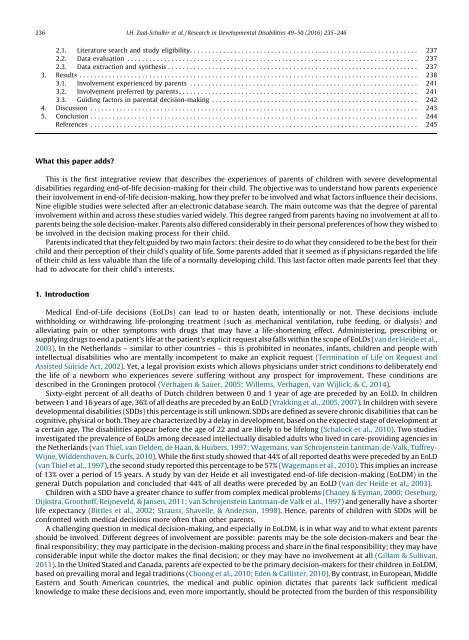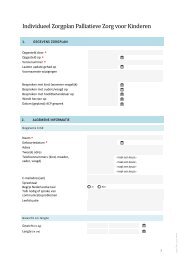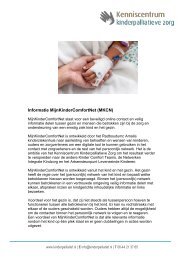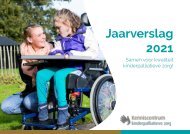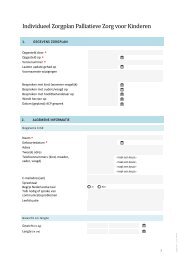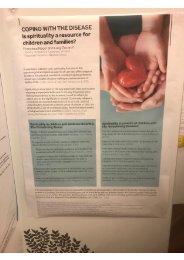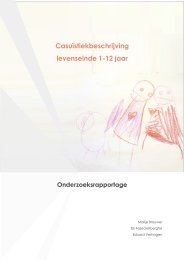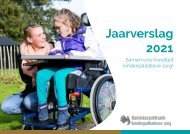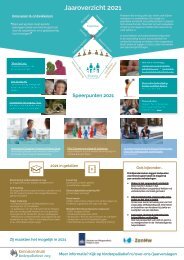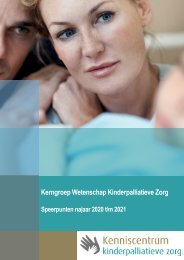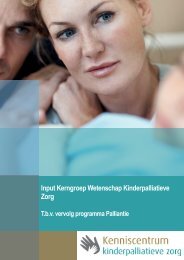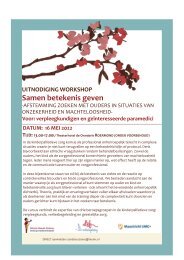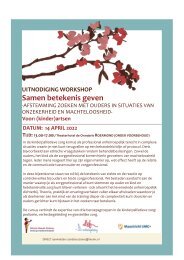End-of-life decision-making for children with severe developmental disabilities
Create successful ePaper yourself
Turn your PDF publications into a flip-book with our unique Google optimized e-Paper software.
236<br />
I.H. Zaal-Schuller et al. / Research in Developmental Disabilities 49–50 (2016) 235–246<br />
2.1. Literature search and study eligibility. . . . . . . . . . . . . . . . . . . . . . . . . . . . . . . . . . . . . . . . . . . . . . . . . . . . . . . . . . . . . . 237<br />
2.2. Data evaluation . . . . . . . . . . . . . . . . . . . . . . . . . . . . . . . . . . . . . . . . . . . . . . . . . . . . . . . . . . . . . . . . . . . . . . . . . . . . . . . 237<br />
2.3. Data extraction and synthesis . . . . . . . . . . . . . . . . . . . . . . . . . . . . . . . . . . . . . . . . . . . . . . . . . . . . . . . . . . . . . . . . . . . . 237<br />
3. Results . . . . . . . . . . . . . . . . . . . . . . . . . . . . . . . . . . . . . . . . . . . . . . . . . . . . . . . . . . . . . . . . . . . . . . . . . . . . . . . . . . . . . . . . . . . . 238<br />
3.1. Involvement experienced by parents . . . . . . . . . . . . . . . . . . . . . . . . . . . . . . . . . . . . . . . . . . . . . . . . . . . . . . . . . . . . . . 241<br />
3.2. Involvement preferred by parents . . . . . . . . . . . . . . . . . . . . . . . . . . . . . . . . . . . . . . . . . . . . . . . . . . . . . . . . . . . . . . . . . 241<br />
3.3. Guiding factors in parental <strong>decision</strong>-<strong>making</strong> . . . . . . . . . . . . . . . . . . . . . . . . . . . . . . . . . . . . . . . . . . . . . . . . . . . . . . . . 242<br />
4. Discussion . . . . . . . . . . . . . . . . . . . . . . . . . . . . . . . . . . . . . . . . . . . . . . . . . . . . . . . . . . . . . . . . . . . . . . . . . . . . . . . . . . . . . . . . . 243<br />
5. Conclusion . . . . . . . . . . . . . . . . . . . . . . . . . . . . . . . . . . . . . . . . . . . . . . . . . . . . . . . . . . . . . . . . . . . . . . . . . . . . . . . . . . . . . . . . . 244<br />
References . . . . . . . . . . . . . . . . . . . . . . . . . . . . . . . . . . . . . . . . . . . . . . . . . . . . . . . . . . . . . . . . . . . . . . . . . . . . . . . . . . . . . . . . . 245<br />
What this paper adds?<br />
This is the first integrative review that describes the experiences <strong>of</strong> parents <strong>of</strong> <strong>children</strong> <strong>with</strong> <strong>severe</strong> <strong>developmental</strong><br />
<strong>disabilities</strong> regarding end-<strong>of</strong>-<strong>life</strong> <strong>decision</strong>-<strong>making</strong> <strong>for</strong> their child. The objective was to understand how parents experience<br />
their involvement in end-<strong>of</strong>-<strong>life</strong> <strong>decision</strong>-<strong>making</strong>, how they prefer to be involved and what factors influence their <strong>decision</strong>s.<br />
Nine eligible studies were selected after an electronic database search. The main outcome was that the degree <strong>of</strong> parental<br />
involvement <strong>with</strong>in and across these studies varied widely. This degree ranged from parents having no involvement at all to<br />
parents being the sole <strong>decision</strong>-maker. Parents also differed considerably in their personal preferences <strong>of</strong> how they wished to<br />
be involved in the <strong>decision</strong> <strong>making</strong> process <strong>for</strong> their child.<br />
Parents indicated that they felt guided by two main factors: their desire to do what they considered to be the best <strong>for</strong> their<br />
child and their perception <strong>of</strong> their child’s quality <strong>of</strong> <strong>life</strong>. Some parents added that it seemed as if physicians regarded the <strong>life</strong><br />
<strong>of</strong> their child as less valuable than the <strong>life</strong> <strong>of</strong> a normally developing child. This last factor <strong>of</strong>ten made parents feel that they<br />
had to advocate <strong>for</strong> their child’s interests.<br />
1. Introduction<br />
Medical <strong>End</strong>-<strong>of</strong>-Life <strong>decision</strong>s (EoLDs) can lead to or hasten death, intentionally or not. These <strong>decision</strong>s include<br />
<strong>with</strong>holding or <strong>with</strong>drawing <strong>life</strong>-prolonging treatment (such as mechanical ventilation, tube feeding, or dialysis) and<br />
alleviating pain or other symptoms <strong>with</strong> drugs that may have a <strong>life</strong>-shortening effect. Administering, prescribing or<br />
supplying drugs to end a patient’s <strong>life</strong> at the patient’s explicit request also falls <strong>with</strong>in the scope <strong>of</strong> EoLDs (van der Heide et al.,<br />
2003). In the Netherlands – similar to other countries – this is prohibited in neonates, infants, <strong>children</strong> and people <strong>with</strong><br />
intellectual <strong>disabilities</strong> who are mentally incompetent to make an explicit request (Termination <strong>of</strong> Life on Request and<br />
Assisted Suicide Act, 2002). Yet, a legal provision exists which allows physicians under strict conditions to deliberately end<br />
the <strong>life</strong> <strong>of</strong> a newborn who experiences <strong>severe</strong> suffering <strong>with</strong>out any prospect <strong>for</strong> improvement. These conditions are<br />
described in the Groningen protocol (Verhagen & Sauer, 2005; Willems, Verhagen, van Wijlick, & C, 2014).<br />
Sixty-eight percent <strong>of</strong> all deaths <strong>of</strong> Dutch <strong>children</strong> between 0 and 1 year <strong>of</strong> age are preceded by an EoLD. In <strong>children</strong><br />
between 1 and 16 years <strong>of</strong> age, 36% <strong>of</strong> all deaths are preceded by an EoLD (Vrakking et al., 2005, 2007). In <strong>children</strong> <strong>with</strong> <strong>severe</strong><br />
<strong>developmental</strong> <strong>disabilities</strong> (SDDs) this percentage is still unknown. SDDs are defined as <strong>severe</strong> chronic <strong>disabilities</strong> that can be<br />
cognitive, physical or both. They are characterized by a delay in development, based on the expected stage <strong>of</strong> development at<br />
a certain age. The <strong>disabilities</strong> appear be<strong>for</strong>e the age <strong>of</strong> 22 and are likely to be <strong>life</strong>long (Schalock et al., 2010). Two studies<br />
investigated the prevalence <strong>of</strong> EoLDs among deceased intellectually disabled adults who lived in care-providing agencies in<br />
the Netherlands (van Thiel, van Delden, de Haan, & Huibers, 1997; Wagemans, van Schrojenstein Lantman-de-Valk, Tuffrey-<br />
Wijne, Widdershoven, & Curfs, 2010). While the first study showed that 44% <strong>of</strong> all reported deaths were preceded by an EoLD<br />
(van Thiel et al., 1997), the second study reported this percentage to be 57% (Wagemans et al., 2010). This implies an increase<br />
<strong>of</strong> 13% over a period <strong>of</strong> 15 years. A study by van der Heide et all investigated end-<strong>of</strong>-<strong>life</strong> <strong>decision</strong>-<strong>making</strong> (EoLDM) in the<br />
general Dutch population and concluded that 44% <strong>of</strong> all deaths were preceded by an EoLD (van der Heide et al., 2003).<br />
Children <strong>with</strong> a SDD have a greater chance to suffer from complex medical problems (Chaney & Eyman, 2000; Oeseburg,<br />
Dijkstra, Grooth<strong>of</strong>f, Reijneveld, & Jansen, 2011; van Schrojenstein Lantman-de Valk et al., 1997) and generally have a shorter<br />
<strong>life</strong> expectancy (Bittles et al., 2002; Strauss, Shavelle, & Anderson, 1998). Hence, parents <strong>of</strong> <strong>children</strong> <strong>with</strong> SDDs will be<br />
confronted <strong>with</strong> medical <strong>decision</strong>s more <strong>of</strong>ten than other parents.<br />
A challenging question in medical <strong>decision</strong>-<strong>making</strong>, and especially in EoLDM, is in what way and to what extent parents<br />
should be involved. Different degrees <strong>of</strong> involvement are possible: parents may be the sole <strong>decision</strong>-makers and bear the<br />
final responsibility; they may participate in the <strong>decision</strong>-<strong>making</strong> process and share in the final responsibility; they may have<br />
considerable input while the doctor makes the final <strong>decision</strong>; or they may have no involvement at all (Gillam & Sullivan,<br />
2011). In the United Stated and Canada, parents are expected to be the primary <strong>decision</strong>-makers <strong>for</strong> their <strong>children</strong> in EoLDM,<br />
based on prevailing moral and legal traditions (Choong et al., 2010; Eden & Callister, 2010). By contrast, in European, Middle<br />
Eastern and South American countries, the medical and public opinion dictates that parents lack sufficient medical<br />
knowledge to make these <strong>decision</strong>s and, even more importantly, should be protected from the burden <strong>of</strong> this responsibility


